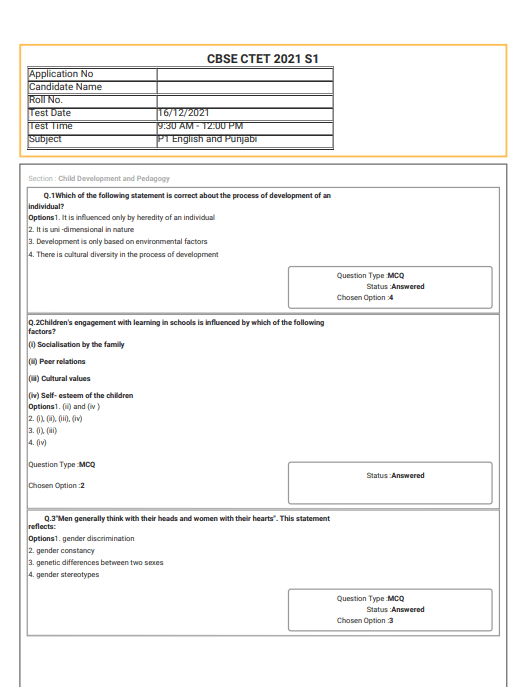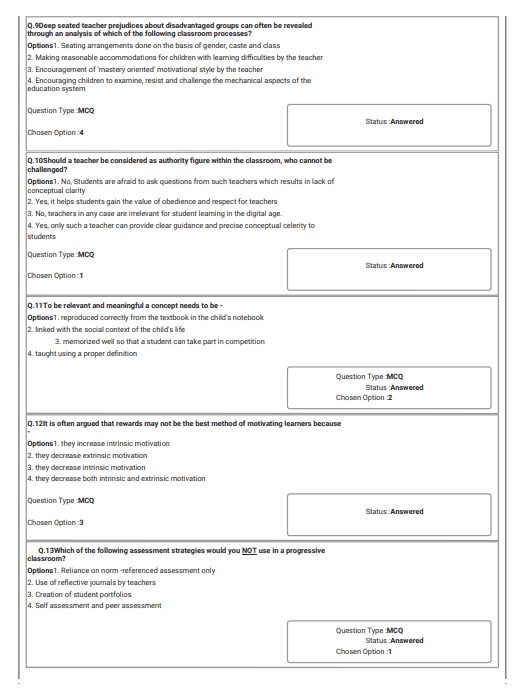CTET Question Paper 2021
Welcome to our exhaustive handbook dedicated to unraveling the intricacies of the CTET Question Paper for the year 2021! Within these pages, we embark on a profound exploration of the Central Teacher Eligibility Test , offering invaluable insights to the empower you in navigating through the examination with unwavering assurance. Whether you’re an ambitious educator poised to undertake the assessment or a seasoned professional endeavoring to refine your pedagogical acumen, this compendium is meticulously crafted to furnish you with indispensable knowledge and resources .
- CTET Question Paper 2021 : Overview
- CTET Question Paper 2021 : Download
- CTET Question Paper 2021: Eligibility Criteria
- CTET Question Paper 2021 : Exam Patten
- CTET Question Paper 2021 : About Application form
- Examining Common Hurdles
- FAQ’s : CTET Question Paper 2021
CTET Question Paper 2021 : Overview
The CTET (Central Teacher Eligibility Test) question papers from 2021 specifically may not offer the most pertinent insights for upcoming examinations due to potential variations in format and content. Nevertheless, I can furnish you with a broad overview of the CTET question paper structure and content domains to aid in your preparation for future CTET assessments.
Test Structure:
The CTET assessment is conducted in an online computer-based format.
It comprises two distinct papers:
Paper 1 caters to teachers (Primary Level).
Paper 2 is tailored for teachers (Elementary Level).
Paper Composition :
Each paper is divided into five sections, each worth 60 marks:
Child Development and Pedagogy (CDP)
Language 1 (English/Hindi)
Language 2 (Selected from a range of languages)
Mathematics
Environmental Studies (EVS)
Total Marks: 150
Content Domains:
Child Development and Pedagogy (CDP): This section encompasses aspects of child psychology, educational theories, effective instructional techniques, and classroom management methodologies.
Language 1 (English/Hindi): This segment evaluates your grasp of language mechanics, vocabulary, and instructional methodologies for the chosen language.
Language 2: Here, the emphasis lies on your proficiency in an alternate Indian language chosen from a selection of options, mirroring the format of Language 1.
Mathematics: This domain evaluates your mathematical acumen, problem-solving abilities, and capacity to elucidate mathematical concepts suitable for the designated grade level (primary or elementary).
Environmental Studies (EVS): This section appraises your understanding of environmental concerns, fundamental scientific principles pertinent to the designated grade level, and pedagogical strategies for effective EVS instruction.
Preparation Resources:
While the specific question papers from 2021 may not be accessible, prior years’ CTET papers (some accompanied by answer keys) are obtainable from various exam preparation platforms. These resources serve to familiarize you with question formats and difficulty levels.
The Central Board of Secondary Education (CBSE) administers the CTET examination. For the most recent CTET notifications, syllabi, and potentially past papers (if available), refer to their website (https://ctet.nic.in/).
Textbooks and study materials aligned with the CTET syllabus offer comprehensive subject coverage and practice opportunities.
Supplementary online resources such as tutorials, video lectures, and practice tests can enhance your preparation endeavors.
By leveraging these resources and concentrating on the current CTET syllabus, you can effectively equip yourself for the impending CTET assessment.
CTET Question Paper 2021 : Download



| Title | Question |
|---|---|
| CTET Question Paper | Click Here |
CTET Question Paper 2021 : Eligibility Criteria.
| Eligibility Criteria | CTET Paper I | Minimum Qualifications | Candidates should have a Graduation degree and passed or appearing in the final year of 2-year Diploma in Elementary Education (by whatever name known) OR Graduation with at least 50% marks and passed or appearing in 1-year Bachelor in Education (B.Ed) OR Graduation with at least 45% marks and passed or appearing in 1-year Bachelor in Education (B.Ed), in accordance with the NCTE (Recognition Norms and Procedure), Regulations issued from time to time in this regard33. |
|---|---|---|
| Relaxation | There is a relaxation of up to 5% in the qualifying marks in the minimum Educational Qualification for candidates belonging to SC/ST/OBC/Differently abled categories. | |
| Teacher Education Program | The candidate should have completed Teacher Education Program recognized by the NCTE, as per the NCTE Regulations, 2002. | |
| Validity Period | The CTET qualifying certificate remains valid for appointment for seven years from the date of declaration of its result for all categories. | |
| Age Limit | There is no age limit prescribed for candidates appearing for the CTET examination. | |
CTET Question Paper 2021 : Exam Patten
| Section | Number of Questions | Marks | Duration |
|---|---|---|---|
| Child Development and Pedagogy (CDP) | 30 | 30 | 2.5 hours (150 min) |
| Language 1 (English/Hindi) | 30 | 30 | |
| Language 2 (Chosen from a list) | 30 | 30 | |
| Mathematics | 30 | 30 | |
| Environmental Studies (EVS) | 30 | 30 | |
| Total | 150 | 150 |
CTET Question Paper 2021 : About Application form
Here you can review some important instructions about Computer Applications Specimen Paper 2024.
- Maximum Marks: 100
- Time allowed: Two hours
- Answers to this Paper must be written on the paper provided separately.
- You will not be allowed to write during the first 15 minutes.
- This time is to be spent in reading the question paper.
- The time given at the head of this Paper is the time allowed for writing the answers.
- This Paper is divided into two Sections.
- Attempt all questions from Section A and any four questions from Section B.
- The intended marks for questions or parts of questions are given in brackets[ ].
Examining Common Hurdles
Starting an educational path frequently means facing typical obstacles that learners face. Identifying these obstacles is the first step in creating winning plans to get over them. Here, we examine a few common issues that students encounter:
- Time management: It might be difficult to strike a balance between extracurricular activity and academic obligations. It can be difficult for students to set aside enough time for each topic or to stick to a regular study schedule.
- Procrastination: The propensity to put off work can make progress difficult. Procrastination frequently stems from a lack of drive or a sense of overwhelm, which makes it difficult to make the most of study time.
- Subject Comprehension: It might be difficult to understand complicated ideas, particularly in areas like science or mathematics. Inadequate study materials or unclear teaching strategies could be part of the problem.
- Exam Anxiety: People frequently struggle with anxiety and nervousness before exams. Stress levels can rise as a result of performance pressure, exam format confusion, or fear of failing.
- Distractions: Social interactions, technological diversions, or a disorganized study space can take attention away from concentrated study periods, which can affect focus and productivity.
- Lack of Resources: Insufficient study materials or restricted access to resources may make thorough preparation difficult. Students that encounter this obstacle could find it difficult to locate additional resources or different teaching aids.
- Motivation and Burnout: It might be difficult to maintain motivation for an extended amount of time. Burnout is a condition marked by physical and mental tiredness and can be brought on by persistently demanding academic work under pressure.
FAQ’s : CTET Question Paper 2021
Q- What is the format of the CTET Question Paper ?
A- The CTET Question Paper follows a multiple-choice format, with four options for each question.
Q- How many sections are there in the CTET Question Paper ?
A- The paper comprises two sections: Paper 1 and Paper 2, each focusing on different educational levels.
Q- Is there negative marking in the CTET Question Paper ?
A- No, there is no negative marking for incorrect answers in the CTET Question Paper .
Q- Can I use a calculator during the CTET Question Paper ?
A- No, calculators or any electronic devices are not permitted during the CTET exam.